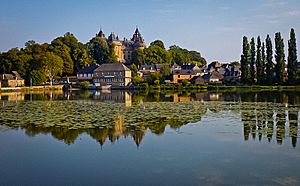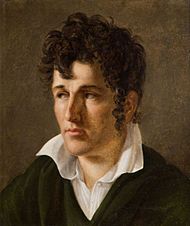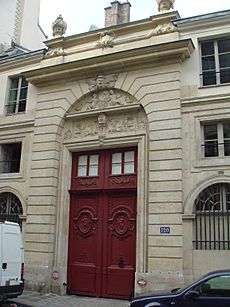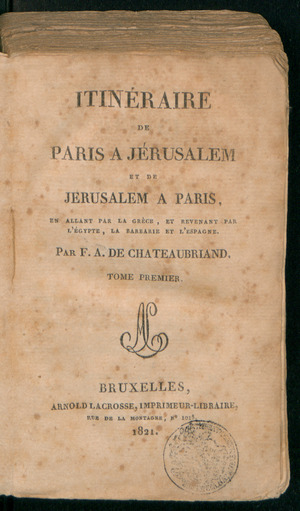François-René de Chateaubriand facts for kids
Quick facts for kids
François-René de Chateaubriand
OLH KOESSH KOSL KOHS KOSM
|
|
|---|---|
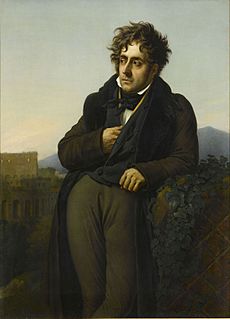
Chateaubriand Meditating on the Ruins of Rome (ca.1810s) by Anne-Louis Girodet de Roussy-Trioson. Oil on canvas.
|
|
| French Ambassador to the Papal States | |
| In office 4 January 1828 – 8 August 1829 |
|
| Appointed by | Jean-Baptiste de Martignac |
| Preceded by | Adrien-Pierre de Montmorency-Laval |
| Succeeded by | Auguste de La Ferronays |
| Minister of Foreign Affairs | |
| In office 28 December 1822 – 4 August 1824 |
|
| Prime Minister | Jean-Baptiste de Villèle |
| Preceded by | Mathieu de Montmorency |
| Succeeded by | Hyacinthe Maxence de Damas |
| French Ambassador to the United Kingdom | |
| In office 22 December 1822 – 28 December 1822 |
|
| Appointed by | Jean-Baptiste de Villèle |
| Preceded by | Antoine de Gramont |
| Succeeded by | Jules de Polignac |
| French Ambassador to Prussia | |
| In office 14 December 1821 – 22 December 1822 |
|
| Appointed by | Jean-Baptiste de Villèle |
| Preceded by | Charles-François de Bonnay |
| Succeeded by | Maximilien Gérard de Rayneval |
| French Ambassador to Sweden | |
| In office 3 April 1814 – 26 September 1815 |
|
| Appointed by | Charles-Maurice de Talleyrand |
| Member of the Académie française | |
| In office 1811–1848 |
|
| Preceded by | Marie-Joseph Chénier |
| Succeeded by | Paul de Noailles |
| Personal details | |
| Born | 4 September 1768 Saint-Malo, Brittany, Kingdom of France |
| Died | 4 July 1848 (aged 79) Paris, Seine, France |
| Spouse |
Céleste Buisson de la Vigne
(m. 1792; |
| Profession | Writer, translator, diplomat |
| Military service | |
| Allegiance | Kingdom of France |
| Branch/service | Armée des Émigrés |
| Years of service | 1792 |
| Rank | Private |
| Battles/wars | |
| Writing career | |
| Period | 19th century |
| Genre | Novel, memoir, essay |
| Subject | Religion, exoticism, existentialism |
| Literary movement | Romanticism Conservatism |
| Years active | 1793–1848 |
| Notable works |
|
| Signature | |
 |
|
François-René de Chateaubriand (born September 4, 1768 – died July 4, 1848) was an important French writer, politician, and diplomat. He greatly influenced French literature in the 1800s. Chateaubriand came from an old noble family in Brittany, France. He was a royalist, meaning he supported the king. At a time when many thinkers were turning away from the Church, he wrote Génie du christianisme to defend the Catholic faith. One of his most famous works is his autobiography, Mémoires d'Outre-Tombe (Memoirs from Beyond the Grave), which was published after he died.
The historian Peter Gay said that Chateaubriand saw himself as the greatest lover, writer, and philosopher of his time. Gay also noted that Chateaubriand "dominated the literary scene in France in the first half of the nineteenth century."
Contents
Biography
Early Life and Exile
François-René de Chateaubriand was born in Saint-Malo on September 4, 1768. He was the last of ten children. He grew up at his family's castle, the château de Combourg, in Combourg, Brittany. His father, René de Chateaubriand, was a former sea captain who became a ship-owner and was involved in the Atlantic slave trade. His mother's name was Apolline de Bedée. Chateaubriand's father was a serious and quiet man. Young Chateaubriand often felt lonely, finding comfort in long walks in the countryside and a close friendship with his sister Lucile.
Chateaubriand went to school in Dol, Rennes, and Dinan. For a while, he wasn't sure if he wanted to be a naval officer or a priest. But at age seventeen, he chose a military career. He became a second lieutenant in the French Army. Within two years, he was promoted to captain. In 1788, he visited Paris and met famous writers like Jean-François de La Harpe and André Chénier.
When the French Revolution began, Chateaubriand first supported it. However, as events in Paris became more violent, he decided to travel to North America in 1791. Guillaume-Chrétien de Lamoignon de Malesherbes encouraged him to leave Europe and study plants.
Journey to America
In his book Voyage en Amérique (published in 1826), Chateaubriand wrote about his trip to America. He said he arrived in Philadelphia on July 10, 1791. He visited New York, Boston, and Lexington. Then he traveled by boat on the Hudson River to Albany. He followed the Mohawk Trail to Niagara Falls, where he broke his arm. He spent a month recovering with a Native American tribe.
Chateaubriand described Native American customs, as well as animals, politics, and the economy. He claimed to have traveled along the Ohio River, the Mississippi River, through Louisiana, and Florida. He then returned to Philadelphia and sailed back to France in November.
His experiences in America inspired his novels Les Natchez (published in 1826), Atala (1801), and René (1802). His lively descriptions of nature in the American Deep South were new for the time. They helped start the Romantic movement in France. Some scholars have questioned if Chateaubriand's claims about meeting George Washington or living with Native Americans were entirely true.
Return to France
Chateaubriand returned to France in 1792. He joined the army of Royalist émigrés (French people who left France during the Revolution) in Koblenz. Under pressure from his family, he married Céleste Buisson de la Vigne, a young noblewoman from Saint-Malo whom he had never met before.
His military career ended when he was wounded at the Siege of Thionville. This was a big fight between Royalist troops and the French Revolutionary Army. Seriously injured, he was taken to Jersey and then exiled to England, leaving his wife behind.
Exile in London
Chateaubriand lived in London for most of his exile, often in great poverty. He earned money by teaching French and doing translation work. He also spent time in Bungay, Suffolk, where he became familiar with English literature. Reading works like John Milton's Paradise Lost (which he later translated) greatly influenced his own writing.
His exile made Chateaubriand think about why the French Revolution happened. Many of his family and friends had died because of it. These thoughts led to his first book, Essai sur les Révolutions (1797). This early work was largely ignored. A major change in Chateaubriand's life was his return to the Catholic faith of his childhood around 1798.
Under Napoleon's Rule
Chateaubriand returned to France in May 1800 after an amnesty was declared for émigrés. He became famous in 1802 with Génie du christianisme ("The Genius of Christianity"). This book defended the Catholic faith and helped bring back religious interest in France after the Revolution. It also gained him the favor of Napoleon Bonaparte, who wanted to improve relations with the Catholic Church.
Chateaubriand was appointed secretary to the French embassy in Rome. He traveled with Cardinal Fesch. However, they soon disagreed, and Chateaubriand was made minister to the Republic of Valais in November 1803. He resigned in anger in 1804 when Napoleon ordered the execution of Louis XVI's cousin, the Duc d'Enghien. After resigning, Chateaubriand relied only on his writing for income. Unexpectedly, he received a large sum of money from the Russian Tsarina Elizabeth Alexeievna, who saw him as a defender of Christianity.
With this money, Chateaubriand traveled in 1806 to Greece, Asia Minor, the Ottoman Empire, Egypt, Tunisia, and Spain. His travel notes became part of his epic story, Les Martyrs. This story was set during the Roman persecution of early Christians. His notes also formed a travelogue, Itinéraire de Paris à Jérusalem (Itinerary from Paris to Jerusalem), published in 1811. The Spanish part of his journey inspired another story, Les aventures du dernier Abencérage (The Adventures of the Last Abencerrage), which came out in 1826.
When he returned to France in late 1806, he wrote a strong criticism of Napoleon. He compared Napoleon to the Roman emperor Nero. Napoleon was very angry and threatened him, but instead just banished him from Paris. So, in 1807, Chateaubriand moved to a small estate called Vallée-aux-Loups ("Wolf Valley"), south of Paris. He lived there until 1817. Here, he finished Les Martyrs (1809) and started writing his Mémoires d’Outre-Tombe. He was elected to the Académie française in 1811. However, he couldn't take his seat until after the Bourbon Restoration because he planned to criticize the Revolution in his acceptance speech. During this time, his friends included writers like Madame de Staël.
Under the Restoration
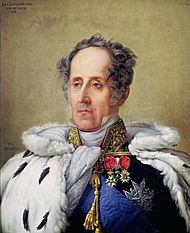
After Napoleon's fall, Chateaubriand supported the Bourbons. In March 1814, he wrote a pamphlet against Napoleon called De Buonaparte et des Bourbons. Thousands of copies were printed. He then followed King Louis XVIII into exile during the Hundred Days (March–July 1815) and was made ambassador to Sweden.
After Napoleon's final defeat at the Battle of Waterloo, Chateaubriand became a peer of France and a state minister in 1815. However, he criticized King Louis XVIII in his work La Monarchie selon la Charte. This led to him losing his position as state minister. He then joined the opposition, supporting the future Charles X, and wrote for their newspaper, Le Conservateur.
Chateaubriand later supported the Court again after the murder of the Duc de Berry in 1820. He then served as ambassador to Prussia (1821) and the United Kingdom (1822). He even became Minister of Foreign Affairs from December 1822 to August 1824. At the Congress of Verona (1822), he supported France's military intervention in Spain. However, he was removed from his office by Prime Minister Joseph de Villèle in June 1824 because he disagreed with a proposed law. Chateaubriand was then appointed French ambassador to Genoa.
After this, he moved towards the liberal opposition. He became very popular as a defender of press freedom and the cause of Greek independence. After Villèle's government fell, Charles X appointed Chateaubriand ambassador to the Holy See in 1828. But he resigned when Prince de Polignac became premier in November 1829.
July Monarchy
In 1830, after the July Revolution, Chateaubriand refused to promise loyalty to the new king, Louis-Philippe. This ended his political career. He left politics to focus on writing his Mémoires d'Outre-Tombe ("Memoirs from Beyond the Grave"). These memoirs were published after his death in 1849–1850. The book shows his growing sadness about the future. While many people around him were hopeful, Chateaubriand felt that chaos and disaster were coming. His writings often talked about the problems he saw every day.
His final work, Vie de Rancé, was published in 1844. It is a biography of Armand Jean le Bouthillier de Rancé, a French aristocrat who left society to become a monk. Chateaubriand continued to revise his Mémoires d’Outre-Tombe until his last years.
Chateaubriand died in Paris on July 4, 1848, during the Revolution of 1848. He was buried, as he wished, on the tidal island Grand Bé near Saint-Malo. This island can only be reached when the tide is out.
Influence
Chateaubriand's descriptions of nature and his thoughts on emotions made him a role model for many Romantic writers. This was true not only in France but also in other countries. For example, Lord Byron was very impressed by René. The young Victor Hugo once wrote, "To be Chateaubriand or nothing." Even his rivals found it hard to ignore his influence.
Chateaubriand was the first to describe the vague des passions ("intimations of passion"), which became a common idea in Romanticism. He wrote, "One inhabits, with a full heart, an empty world." His political ideas sometimes seemed to contradict each other. He wanted to be a friend to both the royal family and to republicans. He would defend whichever side seemed more in danger. He once said, "I am a Bourbonist out of honour, a monarchist out of reason, and a republican out of taste and temperament." He was one of the first French writers to try to have both a political and a literary career.
Chateaubriand believed that "great writers have told their own story in their works." He also said, "One only truly describes one's own heart by attributing it to another, and the greater part of genius is composed of memories." This was certainly true for Chateaubriand himself. All his works contain strong parts of his own life, whether clearly stated or hidden.
Chateaubriand loved food. The famous Chateaubriand steak is most likely named after him.
Honors and Memberships
- In 1806, Chateaubriand became a Knight of the Equestrian Order of the Holy Sepulchre of Jerusalem during a trip to the Holy Land.
- He was elected a member of the American Antiquarian Society in 1816.
- A French school in Rome, Italy, is named after him.
- The cut of meat, a Chateaubriand, is named after him.
Works
- 1797: Essai sur les révolutions
- 1801: Atala, ou Les Amours de Deux Sauvages dans le Desert
- 1802: René
- 1802: Génie du christianisme
- 1809: Les Martyrs
- 1811: Itinéraire de Paris à Jérusalem
- 1814: "On Buonaparte and the Bourbons"
- 1820: Mémoires sur la vie et la mort du duc de Berry
- 1826: Les Natchez
- 1826: Les Aventures du dernier Abencérage
- 1827: Voyage en Amérique
- 1831: Études historiques
- 1833: Mémoires sur la captivité de Madame la duchesse de Berry
- 1844: La Vie de Rancé
- 1848–50: Mémoires d'Outre-Tombe
Images for kids
See also
 In Spanish: François-René de Chateaubriand para niños
In Spanish: François-René de Chateaubriand para niños
- Chateaubriand steak
- List of Ambassadors of France to the United Kingdom


